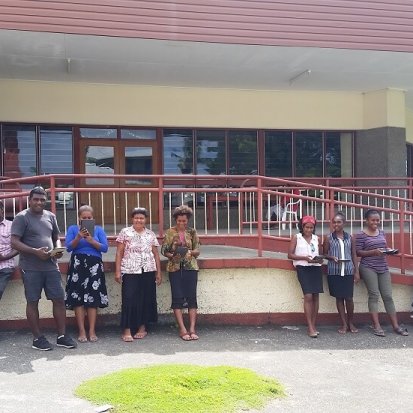A week ago, I wrote about a number of noticeable benefits we identified from our experience using tablet-technology supported data collection for survey work. This drew a number of connections between an earlier piece I wrote in 2016 which bemoaned our choice of using a paper-based survey for a national project in the Solomon Islands.
Based on my experience, I am a strong advocate for tablet-based data collection and taking advantage of the benefits it can bring. However, it is also important to reflect on the perceived risks of such approaches, as well as continually learning and adjusting our practice based on our past project experience.
This blog provides a brief reflection on how we have sought to manage some of these perceived risks, how we have experienced them in the field and how this informs our broader practice and approach.
Reflecting of perceived risks of tablet-based data collection
In 2016, a key reason we used paper-based surveys related to the reported risks of using tablets for data collection. This included the cultural appropriateness of using tablets in the Pacific, interviewer familiarity with smart-phone and tablet technology and their capability to use it in the field, the logistics of access to electricity and internet in remote locations, and other technical problems that could occur.
In a recently completed survey in the Solomon Islands, we used tablets for all field data collection. We also had contingency plans in case any of the above issues emerged. However, as described below, none of these issues raised their heads in substantive or unmanageable ways.
1. Almost all participants were comfortable using tablets. Participants were given the option of using tablet or paper-based surveys, with paper surveys carried in-case the participant chose that option. Over the course of data collection (including over 2,300 responses), in only two circumstances did the participant request the use of the paper survey.
2. Interviewers demonstrated the ability to learn and use the tablets without significant issue. Interviewers who undertook the data collection activity were from a broad range of age groups (19 through to 60) however with support and training they were universally able to successfully use the tablets.
3. No technical issues emerged related to lack of electricity supply or connectivity. Back up battery packs were carried, along with spare tablets, to ensure that data collection could proceed if there was no access to electricity in survey locations. These were not required during the survey process (although this was influenced by the fact survey sites were largely in and around the provincial capitals). While certain locations did not have internet connectivity, there was no issue with data storage on the tablets.
4. None of the tablets or supported material incurred any damage in the field. Tablets were carried in water-proof pelican cases or dry-bags while travelling between provinces to mitigate risk of water damage. Compared to our previous experience, this was a far easier way of transporting the surveys when compared to the volume of paper (also highly vulnerable to water damage) required to do the same amount of survey interviews.
While there was the occasional technical issue in the field – for example, one tablet indicated that the data points were not uploading successfully – the ability to access Akvo’s support team (who were hugely responsive) helped resolve the issue overnight (and if you were wondering, the upload had been successful).
Future application?
Our experience has reiterated the benefit of tablet-based data collection methods where it aligns with the scope of the project and on-the-ground context. Like any type of data collection activity, the use of tablets in the field is not a one-size-fits-all approach and there will be circumstances where it is likely to be either not possible nor desirable.
1. Scale and resourcing. We undertook the training and analysis for a survey with a local research institution in the Eastern Highlands of Papua New Guinea. For reasons of project scale and resources, paper-based surveys were used. While this was successfully employed by the local institution, the time spent on data cleaning and coding the 400 responses for this project was comparable to (and probably greater than) the time spent for the same task in a tablet-supported survey of over 2,300 respondents in the Solomon Island… which gives an indication of the time saved through tablet use. Needless to say, for the scaled-up project, we are proposing the use of tablets to take advantage of many of the benefits above.
2. Security and project context. For a number of other on-going projects in Papua New Guinea, we have taken the advice of our in-country partners on the potential security implications of travelling to certain areas with a large number of tablets. Ultimately, while the benefits that tablets can bring are great, ensuring the wellbeing and security of your team is of far greater importance. That said, the paper-survey forms will be entered through the tablets (rather than directly into an Excel sheet) which will provide the benefits of a much cleaner dataset, and thus still saving time relative to other approaches.
Further information
This blog focused on a number of survey and social research projects Sustineo has completed in Papua New Guinea and the Solomon Islands since 2015. In many of the projects, we have used Akvo Flow as the data collection application, as described above.
Details on these project, and others related to our survey and social research project portfolio, is available here.
If you would like to discuss our experience or work in this space further, please don’t hesitate to get in contact with me at tom.sloan@sustineo.com.au. Follow us on LinkedIn, Twitter and Facebook for more posts like this!
